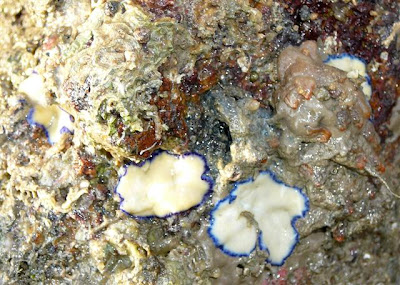
Changi and other northern shores are wonderful places to find these colourful peacock anemones that look like flowers.

On a pillar, I found another anemone that am not sure what it is eventually since its facing downwards.

As usual, Changi has many geographical sea hares. I have noticed though that after daybreak, they tend to burrow downwards.

This stick looking creature is an animal, it is a sea pencil that is actually related to corals.

Yet there is another stick looking creature that I've no idea what exactly it is. It might be an anemone, sea cucumber or something else.

Also spotted among the seagrass beds include this thorny sea cucumber.

The very low tides reveal large carpet anemones near the very low water mark like this one.

It's pleasant to also see purple carpet anemones on our shores, adding on to the variety of colours.

The FIND OF THE DAY is this bailer volute (Melo melo) which is as big as about 20cm in length! It got its common name because the large shell was often used to bail water out of boats.

This is a very rare snail and it is my first time seeing it in the wild. A reason for its rarity will be that it is heavily poached. The bailer volute is thus listed among the threatened animals of Singapore. I hope this one remains in the wild. The last bailer volute was also spotted by Ria and Chay Hoon at Changi, but at a precarious situation where it was already poached. Read more about it at the Wildfilms blog.
In the blog post, Ria stated:
"Is this the last Melo melo on Changi?
We were debating about whether to post about the Melo melo.
If we did, people might actually come look for and remove these beautiful and rare snails. But if we didn't, no one would know that our shores are slowly disappearing into cooking pots.
Recently, it was reported that Malaysia could clone endangered leatherback turtles that face extinction because they "have been hunted for their meat and shells and many get entangled and die in fishing nets in the sea". It is tragic that we only appreciate what we have lost after we have eaten and carelessly killed the last of a special creature."

Other marine wonders found include this shrunk peacock anemone with brittlestairs all around its column.

These pretty brittlestars are shy and hide during the day. So it is good to spot it before the sunrise.

More special finds include this seahorse that clung on to algae and hydroids.

Another seahorse was also found on the same day!

Seahorse is not a horse, it is actually a fish. This green pipefish is in fact a close relative to seahorses. The seahorse is actually a fish because it is equipped with a backbone, (unusual grape-like) gills, swim bladder and fins.

We moved on to check out the rocky habitats and there were many large sized sponges.

As we were flipping rocks to check for rock stars, it was surprising to find four beautiful flatworms together!

Towards the end of the trip, one of my friends found this sea urchin that looks like the salmacis sea urchin but has red spines.

While we were leaving when the tide returns, we chanced upon this monitor lizard busking under the sun. As you can see, it has a forked tongue which it sticks in and out regularly to “smell” its prey.
Changi is indeed teemed with life if we allow it to remain undisturbed.
Nice pictures. Which part of the beach is this? Can't wait to explore the place.
ReplyDelete